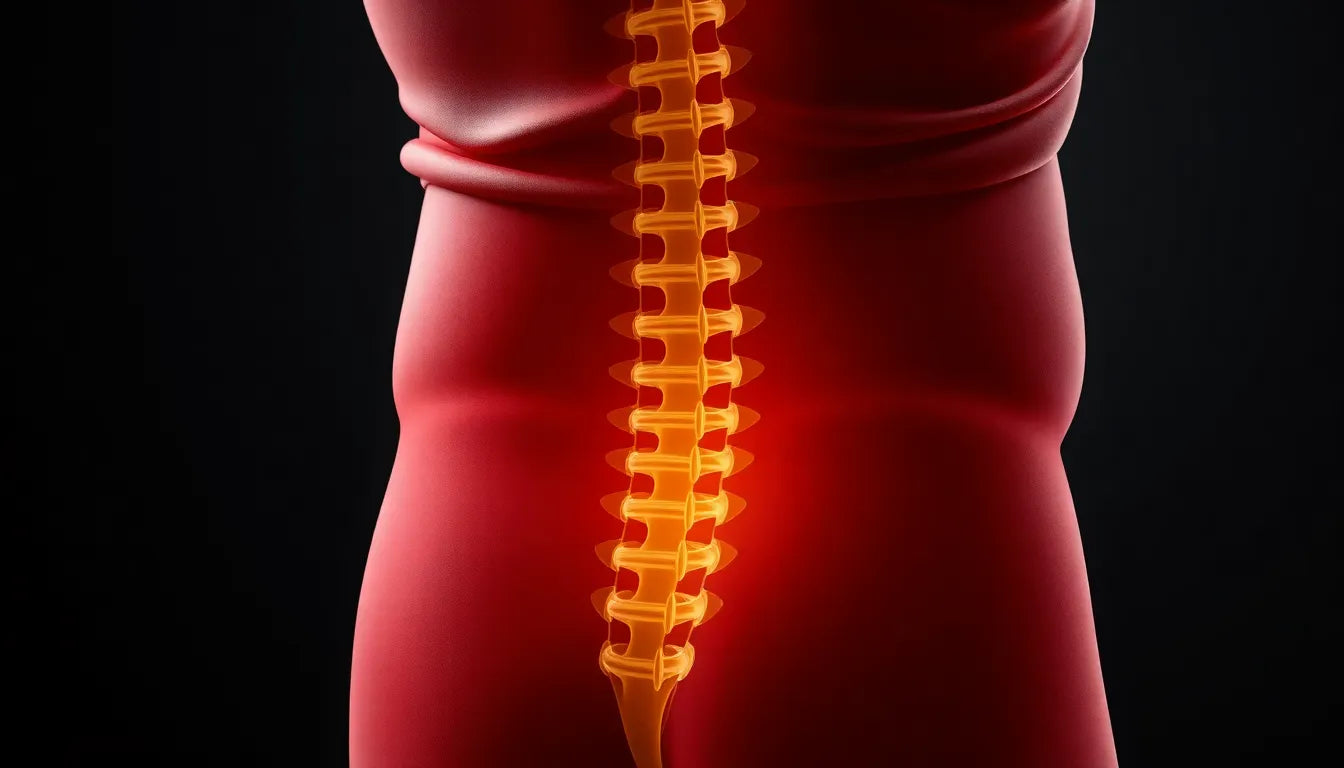Sciatica can be a real pain—literally. This condition arises when the sciatic nerve, which runs from your lower back down to your legs, becomes irritated or compressed. The result? A sharp, shooting pain that can make even the simplest activities feel like a Herculean task. Whether it's a dull ache or a burning sensation, sciatica can disrupt daily life, making it difficult to sit, stand, or even sleep comfortably. For those grappling with this discomfort, finding effective, non-invasive ways to manage the pain is crucial.
understanding sciatica
Sciatica is not a medical diagnosis in itself, but rather a symptom of an underlying condition, such as a herniated disc or spinal stenosis. The hallmark of sciatica is pain that radiates along the path of the sciatic nerve, affecting the lower back, buttocks, and legs. In addition to pain, individuals may experience numbness, tingling, or muscle weakness in the affected leg or foot. The severity of these symptoms can vary, but the impact on daily activities is often significant, leading many to seek relief through various treatment methods.
the role of stretching
One of the most effective and accessible strategies for alleviating sciatica pain is stretching. Regular stretching exercises can help relieve pressure on the sciatic nerve, improve flexibility, and enhance overall function. By incorporating targeted stretches into your routine, you can work towards reducing pain and preventing future flare-ups. Stretching not only addresses the immediate discomfort but also contributes to a healthier spine and improved posture, both of which are essential for long-term relief.

Lumbar support belt
Provides stabilising support for the lower back, ideal for sciatica and lower back pain.
Are you tired of persistent sciatic pain disrupting your life? Discover how simple stretches can offer relief and bring comfort back into your daily routine. In the following sections, we will explore specific stretches designed to target the muscles and areas most affected by sciatica. These exercises are easy to perform at home, require no special equipment, and can be adapted to fit your individual needs. So, let's dive in and unlock the potential of stretching to transform your sciatica experience.
common sciatica stretches for relief
When dealing with sciatica, incorporating specific stretches into your daily routine can provide significant relief. These exercises target muscles that often contribute to sciatic nerve compression, helping to alleviate pain and improve mobility. Here are some effective stretches you can try at home:
piriformis stretch / figure four stretch
The piriformis muscle, located in the buttocks, can exert pressure on the sciatic nerve when tight. To perform this stretch, lie on your back and cross the affected leg over the other, forming a figure four shape. Gently pull the uncrossed leg towards your chest, feeling the stretch in your buttocks and hips. This stretch helps to reduce tension in the piriformis muscle, thereby relieving pressure on the sciatic nerve.
seated glute stretch
This stretch targets the glutes and lower back, areas often tight in individuals with sciatica. Sit on a chair and cross one ankle over the opposite knee. Lean forward slightly, keeping your back straight, until you feel a stretch in your glutes and lower back. This exercise helps to alleviate tension and promote flexibility in the lower back region.
hamstring stretch
Hamstring tightness can contribute to sciatic nerve compression. To stretch your hamstrings, stand and place one foot on a chair or step. Keep your leg straight and gently lean forward, reaching towards your toes. This stretch increases hamstring flexibility, reducing pressure on the sciatic nerve and enhancing overall leg mobility.
spinal twist / sitting spinal stretch
Spinal twists are excellent for increasing spinal mobility and reducing nerve irritation. While sitting, cross one knee over the other and gently twist your torso in the direction of the crossed knee. This movement helps to stretch the muscles around the spine, promoting better alignment and reducing sciatic discomfort.
pelvic tilt and bridging
Strengthening the lower back and core muscles can provide support to the spine and alleviate sciatic pain. To perform pelvic tilts, lie on your back with your knees bent and feet flat on the floor. Tilt your pelvis slightly upward, then lift your hips into a bridge position. Hold for a few seconds before lowering back down. This exercise enhances core stability and helps relieve tension in the lower back.
sciatic nerve gliding / neurodynamic mobilization
Nerve gliding exercises are designed to improve the mobility of the sciatic nerve itself. To perform this exercise, lie on your back and gently bring one knee towards your chest. While holding this position, extend your leg upwards and flex your foot. This coordinated movement helps to mobilize the nerve, reducing symptoms and improving function.
effectiveness of stretching for sciatica
Research consistently shows that regular stretching and exercise can significantly reduce sciatic pain and improve overall function. A study published in the Journal of Physical Therapy Science found that targeted stretching exercises, when performed regularly, can decrease pain intensity and enhance mobility in individuals with sciatica. Personalized physiotherapy routines that include stretching, strength exercises, and nerve glides are particularly effective in managing symptoms and promoting recovery.
Flexibility in the hamstrings and piriformis muscles is crucial for decreasing nerve compression. Tightness in these areas often exacerbates sciatic pain, so focusing on improving flexibility can lead to substantial relief. Moreover, stretching not only addresses immediate discomfort but also contributes to long-term health by promoting a healthier spine and better posture.
Incorporating these stretches into your daily routine can make a noticeable difference in managing sciatica symptoms. However, it's essential to perform them correctly to avoid injury. Consulting with a healthcare provider or physical therapist can ensure that you are executing these exercises safely and effectively. By committing to a regular stretching regimen, you can unlock significant relief from sciatic pain and improve your quality of life.
integration with other therapies for sciatica relief
While stretching is a powerful tool in managing sciatica pain, integrating it with other therapies can enhance its effectiveness. Chiropractic care, for instance, often combines stretching with spinal adjustments, aiming to improve spinal alignment and reduce nerve irritation. These adjustments can complement the benefits of stretching by addressing misalignments that might contribute to sciatic pain.
Physical therapy is another valuable approach, where professionals can tailor a program that includes ergonomic aids and specialized equipment. These tools can help ensure that stretches are performed safely and effectively, reducing the risk of injury. By working with a physical therapist, individuals can receive personalized guidance on how to best incorporate stretching into their broader treatment plan.

Men's Posture Shirt™ - White
Patented shirt improves your posture, relieves pain, and activates core muscles daily.
visual aids and guided tutorials
For those new to stretching or unsure about proper techniques, visual aids and guided tutorials can be incredibly beneficial. Videos and step-by-step guides provide clear instructions on how to perform each stretch correctly, minimizing the risk of improper form that could exacerbate pain. As the trend towards video content grows, many are finding that these resources offer a convenient way to learn and practice self-care routines at home.
Incorporating visual aids into your stretching routine can also enhance motivation and consistency, key factors in achieving long-term relief. Whether through online platforms or mobile apps, accessing guided tutorials can make a significant difference in the effectiveness of your stretching regimen.
conclusion: embracing stretching for sciatica relief
Stretching is a simple yet powerful method for alleviating sciatica pain. By regularly incorporating targeted stretches into your routine, you can reduce nerve pressure, enhance flexibility, and improve overall function. When combined with other therapies like chiropractic care and physical therapy, the benefits of stretching are further amplified, providing a comprehensive approach to managing sciatica.
As you embark on your journey towards pain relief, consider utilizing visual aids and guided tutorials to ensure proper technique and maximize the effectiveness of your efforts. With dedication and the right resources, you can unlock significant relief from sciatica pain and improve your quality of life.
frequently asked questions
What is the best stretch for sciatica pain relief?
The piriformis stretch is highly recommended as it directly targets the muscle that often compresses the sciatic nerve, providing significant relief.
How often should I perform these stretches?
It is generally recommended to perform these stretches daily. However, always consult with a healthcare provider for personalized advice that considers your specific condition and needs.
Can stretching alone cure sciatica?
While stretching can significantly alleviate symptoms and improve mobility, it is often most effective when combined with other treatments like physical therapy and chiropractic care.
Are there any risks associated with sciatica stretches?
When done correctly, these stretches are safe. However, improper technique can exacerbate pain, so it's crucial to follow guidelines or consult a professional to ensure you're performing them correctly.
When should I see a doctor for sciatica pain?
If pain persists despite regular stretching and self-care, or if it worsens, seek medical advice to explore further treatment options. A healthcare professional can provide a comprehensive assessment and recommend appropriate interventions.
Källor
- Harvard Health Publishing. "Sciatica: Gentle Stretches to Help Relieve Pain and Improve Mobility."
- National Center for Biotechnology Information. "Sciatica: Clinical Evidence and Pathophysiology."
- American Family Physician. "Diagnosis and Treatment of Acute Low Back Pain."
- Orthopaedics Plus. "New Research: How to Fix Sciatica."
- National Center for Biotechnology Information. "Sciatica."
- National Center for Biotechnology Information. "Effectiveness of Physical Therapy in Sciatica."
- NHS. "Exercises for Sciatica Problems."
- Mayo Clinic. "Sciatica: Diagnosis & Treatment."
- Hospital for Special Surgery. "Move Better: Sciatica Stretches."
- Cleveland Clinic. "Sciatica."























